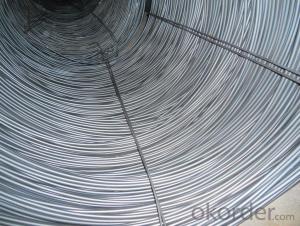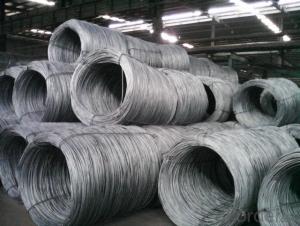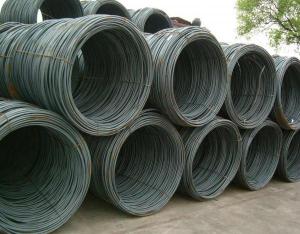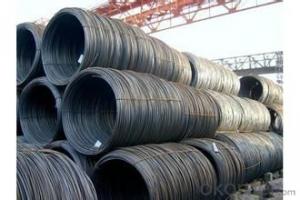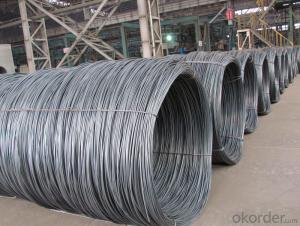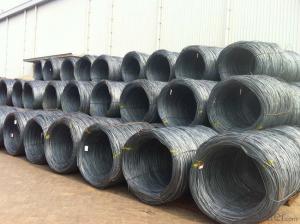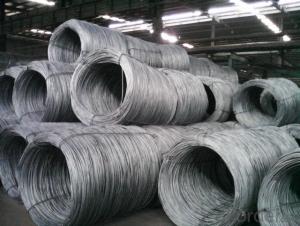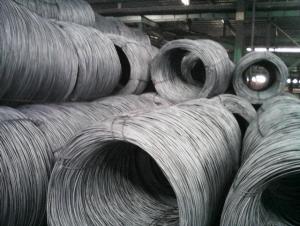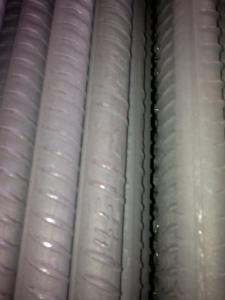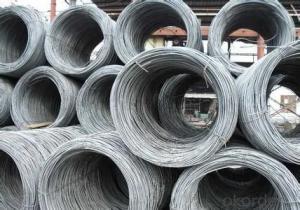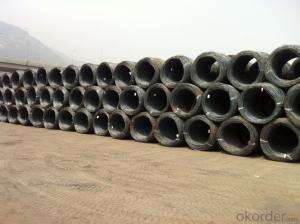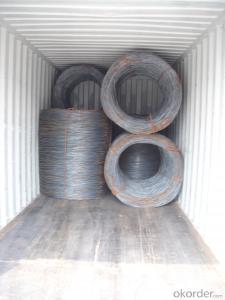Alloy Low Carbon Steel Wire Rod or Metal Wire
- Loading Port:
- China main port
- Payment Terms:
- TT or LC
- Min Order Qty:
- 100 m.t.
- Supply Capability:
- 10000 m.t./month
OKorder Service Pledge
OKorder Financial Service
You Might Also Like
Specification
OKorder is offeringAlloy Low Carbon Steel Wire Rod or Metal Wire at great prices with worldwide shipping. Our supplier is a world-class manufacturer of steel, with our products utilized the world over. OKorder annually supplies products to African, South American and Asian markets. We provide quotations within 24 hours of receiving an inquiry and guarantee competitive prices.
Product Applications:
Alloy Low Carbon Steel Wire Rod or Metal Wire are ideal for structural applications and are widely used in reinforcement of reinforced concrete and welded structure or reprocessed (roberts , nail, etc.) materials, especially used to produce wire drawing, welding electrode, nails, spring, electronic, precise machinery parts and so on.
Product Advantages:
OKorder's Alloy Low Carbon Steel Wire Rod or Metal Wire are durable, strong, and wide variety of sizes.
Main Product Features:
· Premium quality
· Prompt delivery & seaworthy packing (30 days after receiving deposit)
· Can be recycled and reused
· Mill test certification
· Professional Service
· Competitive pricing
Product Specifications:
Steel Grade: Q195/235, SAE1006-1018B
Standard: ASTM, GB
Diameter: 5.5mm, 6.5mm, 7mm,8mm,9mm,10mm,12mm,14mm
Type: in coil, coil weight around 2MT
Alloy or Not: Alloy
Technique: Hot Rolled
Place of Origin: China Mainland
Surface: round, no twisted, light and smooth
Grade | Chemical Composition(%) | |||||
C | Mn | Si | S | P | B | |
SAE1006B | 0.03~O.07 | ≤0.32 | ≤0.30 | ≤0.045 | ≤0.040 | >0.0008 |
Mechanical properties | ||||||
Yield strength(N/mm2) | Tensile strength(N/mm2) | Elongation(%) | ||||
250-280 | 350-380 | ≥32 | ||||
Grade | Chemical Composition(%) | |||||
C | Mn | Si | S | P | B | |
SAE1008B | 0.10max | 0.3~O.50 | 0.15max | 0.050max | 0.040 max | 0.0008 min |
Mechanical properties | ||||||
Yield strength(N/mm2) | Tensile strength(N/mm2) | Elongation(%) | ||||
≥195 | 315-430 | ≥30 | ||||
FAQ:
Q1: Why buy Materials & Equipment from OKorder.com?
A1: All products offered byOKorder.com are carefully selected from China's most reliable manufacturing enterprises. Through its ISO certifications, OKorder.com adheres to the highest standards and a commitment to supply chain safety and customer satisfaction.
Q2: How do we guarantee the quality of our products?
A2: We have established an advanced quality management system which conducts strict quality tests at every step, from raw materials to the final product. At the same time, we provide extensive follow-up service assurances as required.
Q3: How soon can we receive the product after purchase?
A3: Within three days of placing an order, we will arrange production. The normal sizes with the normal grade can be produced within one month. The specific shipping date is dependent upon international and government factors, the delivery to international main port about 45-60days.
Images:
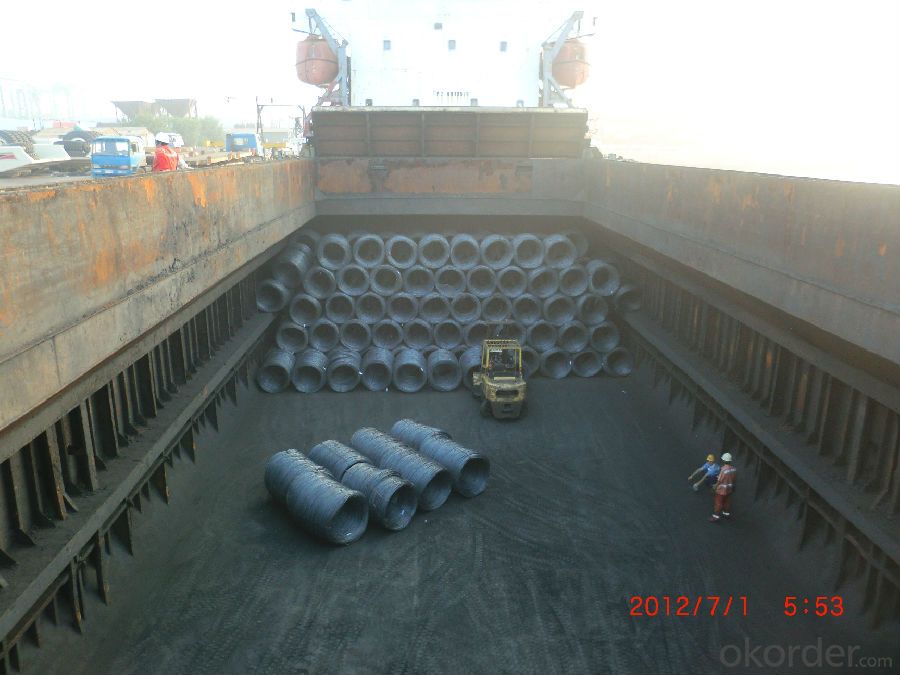
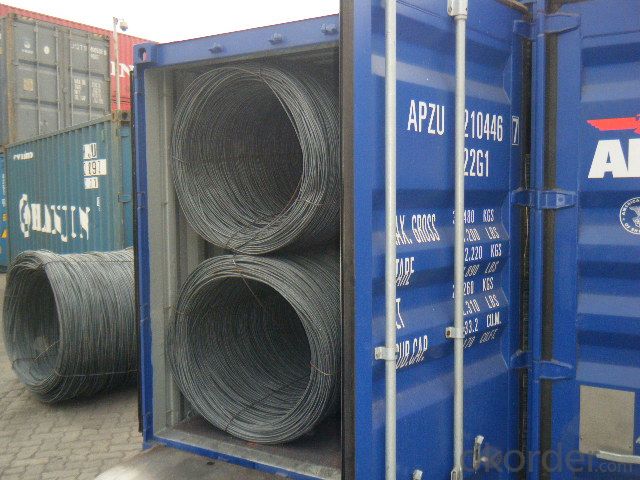
- Q: How is steel wire rod used in the production of wire for wire rope slings?
- The production of wire rope slings relies heavily on steel wire rod. This raw material is used to manufacture the wire ropes that are essential components of wire rope slings. To transform the wire rod into wire ropes, a series of manufacturing steps are undertaken. These steps include drawing, stranding, and closing the wire ropes. Initially, the wire rod is drawn through a die to decrease its diameter and increase its length. This process enhances the wire's strength and flexibility. Once the drawing process is complete, the wire rod is then stranded by twisting multiple wires together to form a strand. Multiple strands are further twisted to create the wire rope. This stranding process adds strength and durability to the wire rope, making it suitable for demanding applications. To complete the manufacturing process, the wire rope is closed by utilizing specialized machinery to form a loop or an eye on one or both ends. This closure ensures a secure attachment of the wire rope to equipment or structures, allowing for safe lifting and handling. In summary, steel wire rod plays a crucial role in the production of wire for wire rope slings. Through various manufacturing processes, the wire rod is transformed into wire ropes that possess exceptional strength, flexibility, and durability. These wire ropes are then utilized in the construction of wire rope slings, which are extensively used in lifting and rigging operations across diverse industries.
- Q: What are the different microscopy techniques used for steel wire rod analysis?
- There are several microscopy techniques that can be used for steel wire rod analysis. These techniques provide valuable information about the microstructure, composition, and defects in the wire rod. 1. Optical Microscopy: This is a commonly used technique that involves using visible light to observe the microstructure of the wire rod. It can provide information about the grain size, grain boundaries, and any visible defects such as cracks or inclusions. 2. Scanning Electron Microscopy (SEM): SEM uses a focused beam of electrons to obtain high-resolution images of the wire rod's surface. It can provide information about the surface morphology, elemental composition, and the presence of any surface defects or contaminants. 3. Transmission Electron Microscopy (TEM): TEM is a powerful technique that involves passing a beam of electrons through a thin section of the wire rod to obtain detailed images of the internal microstructure. It can provide information about the crystal structure, grain boundaries, and the presence of any precipitates or defects at the atomic level. 4. Electron Backscatter Diffraction (EBSD): EBSD is a technique that combines SEM with crystallography to determine the orientation and grain structure of the wire rod. It can provide information about the crystallographic texture, grain size distribution, and any deformation or recrystallization that may have occurred during processing. 5. X-ray Diffraction (XRD): XRD is a technique that involves directing X-rays onto the wire rod's surface to analyze its crystal structure. It can provide information about the phase composition, crystallographic orientation, and the presence of any residual stress or strain in the wire rod. 6. Atomic Force Microscopy (AFM): AFM uses a small probe to scan the surface of the wire rod and obtain high-resolution images. It can provide information about the surface topography, roughness, and the presence of any surface defects such as scratches or pits. By utilizing these various microscopy techniques, researchers and engineers can gain a comprehensive understanding of the microstructure, composition, and defects in steel wire rods, which is crucial for quality control, process optimization, and material development in the steel industry.
- Q: What is a cold drawn steel wire? What does it usually do?
- Cold drawn low carbon steel wire used for prestressed concrete structures, such as beam, hollow floor, small poles, and rural construction of the purlin and door and window frames etc..
- Q: How is steel wire rod inspected for surface defects?
- Steel wire rod is inspected for surface defects through a process known as visual inspection and non-destructive testing. Firstly, visual inspection is performed by trained personnel who carefully examine the surface of the wire rod for any visible defects such as scratches, cracks, pits, or deformations. This is done by using proper lighting and magnifying tools to ensure thorough detection. In addition to visual inspection, non-destructive testing techniques are employed to further assess the quality of the wire rod. One commonly used method is magnetic particle inspection, which involves magnetizing the wire rod and applying a magnetic particle solution on its surface. Any surface defects, such as cracks or discontinuities, will cause the magnetic particles to cluster together, making the defect visible. Another method used is ultrasonic testing, where high-frequency sound waves are transmitted through the wire rod. These waves are then reflected back by any internal or external defects, allowing the inspector to detect and measure the size and depth of the defects. Furthermore, eddy current testing is another non-destructive technique utilized for surface inspection. It involves inducing an electric current in the wire rod and measuring the resulting magnetic field. Any surface defects will cause changes in the magnetic field, which are then detected by the inspection equipment. Overall, a combination of visual inspection and non-destructive testing methods is employed to ensure that steel wire rods are thoroughly inspected for surface defects, providing a reliable and high-quality product to consumers.
- Q: What are the different cutting methods for steel wire rod?
- There are several different cutting methods for steel wire rod, including shearing, sawing, grinding, and laser cutting. Shearing involves using a cutting tool to separate the wire rod at a specific point, while sawing utilizes a saw blade to cut through the rod. Grinding involves using an abrasive wheel to remove material and cut through the wire rod. Laser cutting uses a high-powered laser beam to melt and vaporize the wire rod, creating a precise cut. Each method has its own advantages and is chosen based on the specific requirements of the application.
- Q: What are the mechanical properties of steel wire rod?
- The mechanical properties of steel wire rod mainly include its tensile strength, yield strength, elongation, and hardness. These properties determine the wire rod's ability to withstand applied forces, its flexibility, and its resistance to deformation.
- Q: How is the surface hardness of steel wire rod measured?
- The surface hardness of steel wire rod is typically measured using the Rockwell hardness test or the Brinell hardness test. These tests involve applying a specific amount of pressure to the surface of the steel wire rod and then measuring the depth of penetration or the size of the indentation created. The resulting hardness value provides an indication of the material's resistance to deformation and its overall strength.
- Q: What are the different types of heat treatments used for steel wire rod?
- There are several types of heat treatments used for steel wire rod, including annealing, quenching and tempering, normalizing, and stress relieving. Each treatment has its own purpose and helps to improve the mechanical properties of the steel wire rod.
- Q: What are the safety precautions for handling steel wire rod?
- Some safety precautions for handling steel wire rod include wearing appropriate personal protective equipment such as gloves, safety glasses, and steel-toed boots. It is important to handle the rods with care to avoid injuries, such as cuts or punctures. Additionally, workers should be trained on proper lifting techniques to prevent strains or back injuries. Regular inspections of the rods and equipment should also be conducted to identify any potential hazards or defects.
- Q: What are the different surface marking methods for steel wire rod?
- There are several surface marking methods that can be used for steel wire rods. These methods are used to identify and provide information about the wire rod, such as its grade, size, and manufacturer. One common method is hot stamping, where an identification mark is impressed onto the surface of the wire rod using a heated stamp. This method is effective and durable, as the mark is permanently engraved onto the surface of the steel. Another method is inkjet printing, where an inkjet printer is used to directly print the required information onto the steel wire rod. This method is fast and allows for flexibility in marking various types of information. Laser marking is also a popular method, where a laser beam is used to remove or change the surface material of the wire rod, creating a permanent mark. This method provides high precision and a high level of detail in the markings. Additionally, embossing or engraving can be used to create raised or indented markings on the surface of the wire rod. These methods are often used for branding or decorative purposes, but can also be used to provide important information about the wire rod. Overall, the choice of surface marking method for steel wire rods depends on the specific requirements and preferences of the manufacturer. Each method has its own advantages and limitations, and it is important to select the most suitable method to ensure accurate and durable markings on the wire rods.
Send your message to us
Alloy Low Carbon Steel Wire Rod or Metal Wire
- Loading Port:
- China main port
- Payment Terms:
- TT or LC
- Min Order Qty:
- 100 m.t.
- Supply Capability:
- 10000 m.t./month
OKorder Service Pledge
OKorder Financial Service
Similar products
Hot products
Hot Searches
Related keywords


